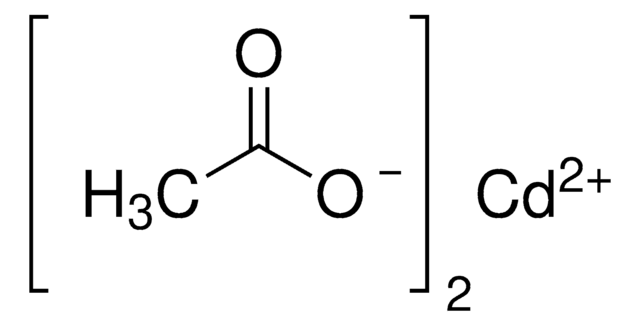202908
Cadmium chloride
99.99% trace metals basis
Sinónimos:
Cadmium dichloride, Dichlorocadmium
About This Item
Productos recomendados
grade
for analytical purposes
Quality Level
vapor density
6.3 (vs air)
vapor pressure
10 mmHg ( 656 °C)
assay
99.99% trace metals basis
form
solid
reaction suitability
reagent type: catalyst
core: cadmium
impurities
≤150.0 ppm Trace Metal Analysis
mp
568 °C (lit.)
solubility
H2O: soluble 457 g/L at 20 °C (OECD Test Guideline 105)
SMILES string
Cl[Cd]Cl
InChI
1S/Cd.2ClH/h;2*1H/q+2;;/p-2
InChI key
YKYOUMDCQGMQQO-UHFFFAOYSA-L
¿Está buscando productos similares? Visita Guía de comparación de productos
Categorías relacionadas
General description
Application
- As an additive to fabricate perovskite solar cells to improve long-term stability and performance. The incorporation of Cd ions enhances optical absorption and carrier transfer.
- As a precursor to synthesize functionalized cadmium telluride quantum dots for fluorescent immunosensors.
- Aza-Michael reaction of electron-deficient alkene and a wide range of amines.
- The one-pot synthesis of dihydropyrimidones via the Biginelli reaction.
- The synthesis of benimidazoles.
signalword
Danger
Hazard Classifications
Acute Tox. 2 Inhalation - Acute Tox. 3 Oral - Aquatic Acute 1 - Aquatic Chronic 1 - Carc. 1B - Muta. 1B - Repr. 1B - STOT RE 1
Storage Class
6.1A - Combustible acute toxic Cat. 1 and 2 / very toxic hazardous materials
wgk_germany
WGK 3
ppe
Eyeshields, Faceshields, Gloves, type P3 (EN 143) respirator cartridges
Elija entre una de las versiones más recientes:
¿Ya tiene este producto?
Encuentre la documentación para los productos que ha comprado recientemente en la Biblioteca de documentos.
Los clientes también vieron
Artículos
From Form to Function: Molding Porous Materials in Three Dimensions by Colloidal Crystal Templating
Colloidal quantum dots (CQDs) are semiconducting crystals of only a few nanometers (ca. 2–12 nm) coated with ligand/surfactant molecules to help prevent agglomeration.
Global Trade Item Number
| Número de referencia del producto (SKU) | GTIN |
|---|---|
| 202908-10G | 4061838765376 |
| 202908-250G | |
| 202908-50G | 4061838765383 |
Nuestro equipo de científicos tiene experiencia en todas las áreas de investigación: Ciencias de la vida, Ciencia de los materiales, Síntesis química, Cromatografía, Analítica y muchas otras.
Póngase en contacto con el Servicio técnico










